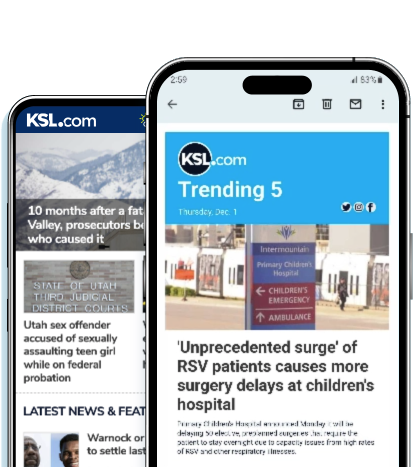- Utah plans to install 19 air quality monitors around the Great Salt Lake and West Desert.
- This initiative aims to track dust storms and their health impacts on residents.
- The data may lead to a future warning system for incoming dust storms.
Editor's note: This article is published through the Great Salt Lake Collaborative, a solutions journalism initiative that partners news, education and media organizations to help inform people about the plight of the Great Salt Lake.
SALT LAKE CITY — Great Salt Lake-related air quality concerns could intensify this summer as the air quality falls closer to its "serious adverse effects" range of the state's lake management plan.
The lake's southern arm is only about a foot above that threshold now, and long-range outlooks suggest the lake could be in for another rough summer after it lost 3 feet last year. State officials don't believe its drop will impact salinity levels — a key factor in the lake's ecosystem health — anytime soon, but they say it could impact recreation and also reexpose more of its lakebed, blowing dust into communities close to the lake.
However, the state also hopes to have a network of air quality monitors set up soon that could help researchers better understand what's in the Great Salt Lake dust and how far it travels, which could also potentially lead to a future system that warns residents about incoming dust storms.
"We want to understand where the dust goes, how it shifts, where it could lead to … the worst air quality," said Gov. Spencer Cox during his monthly briefing with Utah reporters on Tuesday.
There is some preliminary dust data already available, but it isn't enough to help the agencies that track the Great Salt Lake or state air quality to completely know the origin of a dust storm, how far the dust travels or the health impacts of each type of source, said Great Salt Lake Commissioner Brian Steed.
"It's one of the major data gaps that we've had," he explained in a briefing with reporters earlier on Tuesday.
State environmental employees are now able to set up an initial network of 19 air quality monitors, and they were given funding this year for a new state employee who will track data from the sites, said Tim Davis, executive director of the Utah Department of Environmental Quality. He also tasked the Utah Division of Air Quality, an agency within his department, to create a dust management plan, which is being reviewed by outside experts.
Officials are still determining where these monitors will go, but they will be set up around the Great Salt Lake and within surrounding communities, as well as in areas by the West Desert, the dried Sevier Lake and near the Utah-Nevada border. Some of these could be installed later this year.
Once it's set up, a mix of monitors that continuously collect data and monitors that collect dust particle samples will enable researchers to understand when there's an event and what is in the dust during that event, Davis explains.
The data gathered from the monitors could then influence future policy decisions. It could help pinpoint dust hot spots, allowing the state to "engineer ways to get those areas covered with water," Cox said. It could also see if some dust sources have different potential health impacts than others.
It could also lead to a new dust warning system sometime down the road, Davis adds.
"(We want to) be able to get information about dust, Great Salt Lake dust, to people — let them know what's in it (and) develop tools to get people a heads up when a potential dust storm could be coming so people who are sensitive — for example, if they have asthma — they can protect themselves," he said. "But the first step — and what we haven't done today — is develop the dust network."
Contributing: Bridger Beal-Cvetko









